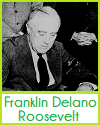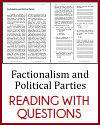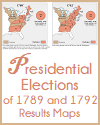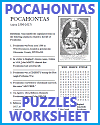The Nullification Crisis |
|
Toward the end of his first term in office, Jackson was forced to confront the state of South Carolina, the most important of the emerging Deep South cotton states, on the issue of the protective tariff. Business and farming interests in the state had hoped that the president would use his power to modify the 1828 act that they called the Tariff of Abominations. In their view, all its benefits of protection went to Northern manufacturers, leaving agricultural South Carolina poorer. In 1828, the state's leading politician – and Jackson's vice president until his resignation in 1832 – John C. Calhoun had declared in his South Carolina Exposition and Protest that states had the right to nullify oppressive national legislation.
In response to South Carolina's threat, Jackson sent seven small naval vessels and a man-of-war to Charleston in November 1832. On December 10, he issued a resounding proclamation against the nullifiers. South Carolina, the president declared, stood on "the brink of insurrection and treason," and he appealed to the people of the state to reassert their allegiance to the Union. He also let it be known that, if necessary, he personally would lead the U.S. Army to enforce the law. When the question of tariff duties again came before Congress, Jackson’s political rival, Senator Henry Clay, a great advocate of protection but also a devoted Unionist, sponsored a compromise measure. Clay's tariff bill, quickly passed in 1833, specified that all duties in excess of 20 percent of the value of the goods imported were to be reduced year by year, so that by 1842 the duties on all articles would reach the level of the moderate tariff of 1816. At the same time, Congress passed a Force Act, authorizing the president to use military power to enforce the laws. South Carolina had expected the support of other Southern
states, but instead found itself isolated. (Its most
likely ally, the state government of Georgia, wanted, and got,
U.S. military force to remove Native-American tribes from the
state.) Eventually, South Carolina rescinded its action.
Both sides, nevertheless, claimed victory. Jackson had
strongly defended the Union. But South Carolina, by its
show of resistance, had obtained many of its demands and had
demonstrated that a single state could force its will on
Congress. |
Answer Key: (1) D - South Carolina; (2) John C. Calhoun; (3) nullification; (4) Charleston, South Carolina; (5) Henry Clay; (6) Georgia; (7) Answers will vary. Click here to print. |
|---|
 |
|---|
Text courtesy of the U.S. State Department, Bureau of International Information Programs, 2005 |


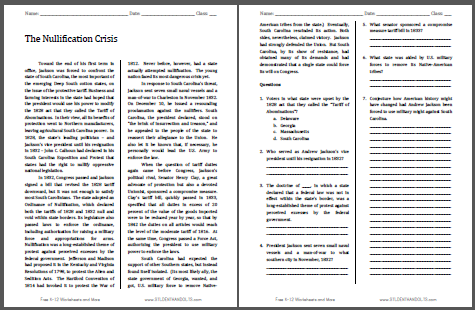 In 1832, Congress passed and Jackson signed a bill that
revised the 1828 tariff downward, but it was not enough to
satisfy most South Carolinians. The state adopted an
Ordinance of Nullification, which declared both the tariffs of
1828 and 1832 null and void within state borders. Its
legislature also passed laws to enforce the ordinance, including
authorization for raising a military force and appropriations
for arms. Nullification was a long-established theme of
protest against perceived excesses by the federal government.
Jefferson and Madison had proposed it in the Kentucky and
Virginia Resolutions of 1798, to protest the Alien and Sedition
Acts. The Hartford Convention of 1814 had invoked it to
protest the War of 1812. Never before, however, had a
state actually attempted nullification. The young nation
faced its most dangerous crisis yet.
In 1832, Congress passed and Jackson signed a bill that
revised the 1828 tariff downward, but it was not enough to
satisfy most South Carolinians. The state adopted an
Ordinance of Nullification, which declared both the tariffs of
1828 and 1832 null and void within state borders. Its
legislature also passed laws to enforce the ordinance, including
authorization for raising a military force and appropriations
for arms. Nullification was a long-established theme of
protest against perceived excesses by the federal government.
Jefferson and Madison had proposed it in the Kentucky and
Virginia Resolutions of 1798, to protest the Alien and Sedition
Acts. The Hartford Convention of 1814 had invoked it to
protest the War of 1812. Never before, however, had a
state actually attempted nullification. The young nation
faced its most dangerous crisis yet.

